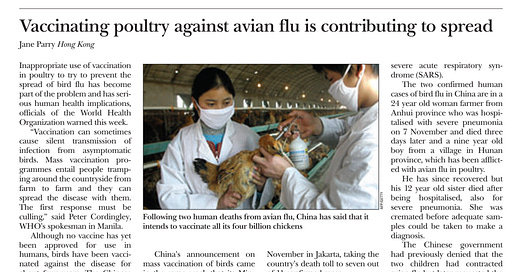Vaccinating Poultry is "Part of the Problem"
Ineffective and dangerous strategy emerged over past twenty years
By Peter A. McCullough, MD, MPH, Nicolas Hulscher, MPH (Candidate), John S. Leake
With all the buzz about highly pathogenic H5N1 avian influenza (HPAI), we thought it would be useful to review this chapter in vaccine history. It turns out that Asian countries have deployed vaccines since 1995 and China started vaccinating poultry in 2004. In the same year the US had its first outbreak of H5N2 avian influenza in over 20 years.
On 17 February 2004, the state of Texas reported the detection of a type A influenza virus from chickens. The mild clinical signs observed in the affected flock were consistent with an infection caused by a low pathogenicity AIV. However, the presence of multiple basic amino acids at the HA cleavage site, which was identical to the amino acid sequence in the highly pathogenic A/chicken/Scotland/59 (H5N1) virus, required that the United States Department of Agriculture (USDA) National Veterinary Services Laboratories report that the A/chicken/Texas/298313/04 (TX/04) (H5N2) isolate was classified as a highly pathogenic AIV on 23 February 2004. However, on 1 March 2004, National Veterinary Services Laboratories announced the results of the chicken pathogenicity test that showed the virus as being avirulent for chickens; the chickens remained healthy throughout the 10-day observation period.
From 2003-2005, wild birds spread HPAI H5N1 virus to poultry in Africa, the Middle East and Europe, and the Spike protein or hemagglutinin on the viral surface diversified into numerous clades (related groups), and viruses reassorted into multiple genetic lineages (genotypes) that were detected around the world. At that time, a WHO spokesman in Manila stated his belief that vaccinating poultry against avian flu was contributing to the virus’s spread.
Guyonnet et al, published a review in 2020 which we found very helpful. Here are some key excerpts:
The antigenic variation of the hemagglutinin (HA) and neuraminidase (NA) surface glycoproteins occurs at a high frequency through minor “drift” changes and may be associated with the immune pressure exerted by the vaccination of birds…[avian influenza (AI)] during the period January 2013–February 2019 resulted in the loss of approximately 128 million birds, with more than half (57.6%) of the reported losses in Asia, followed by the Americas (22.1%) and Europe (13.4%). Poultry AI vaccines used in the field are based on five technologies: 1) wild-type or reverse genetics whole AI virus grown in embryonated chicken eggs, then chemically inactivated and adjuvanted; 2) HA antigen or virus-like particles produced in insect cells by a genetically engineered baculovirus; 3) HA DNA vaccine adjuvanted; 4) recombinant technologies utilizing live virus vectors to express AI virus HA and in some cases NA gene inserts (recombinant Herpes turkey virus (rHVT-AIV), recombinant Newcastle disease virus (rNDV-AIV) and recombinant Fowl pox virus (rFPV-AIV)) and, 5) defective-replicating alphavirus (defective Venezuelan Equine Encephalitis virus with H5 AI virus gene insert…Vaccine database from The Center for Food Security and Public Health, Iowa State University showed that of 43 manufacturers listing vaccines for the control of Avian Influenza, 31 (72%) are currently manufacturing vaccines combining AI with other antigens (CFSPH, 2018). These manufacturers are based in 11 different countries on five continents but the majority of them (71%) are located in Asia (22 of the 31) where AI vaccination has been practiced since 1995. Manufacturers located in Europe and North America are producing vaccines mostly for export and for the setting-up of emergency stocks. According to the OIE website (OIE, 2019), the countries with official AI vaccination programs are Mexico, Egypt, Pakistan, Kazakhstan and Russia. China also has official AI vaccination. Vaccination is also allowed in Bangladesh where import permits are delivered to the private sector and killed AI vaccines imported (no combination vaccines used). Vietnam, Egypt and Indonesia have transitioned from mass vaccination to targeted vaccination ( OFFLU, 2013). The cost of AI vaccination is often shared between governments and the private sector.
So it has been “game-on” for mass vaccination (traditional and genetic) of poultry around the world over the last 20 years. Otherwise flock outbreaks were managed with culling supported by government subsidies.
Among major poultry producers, there appears to be no attempt to allow natural immunity from infection to settle. If avian flu is detected on a poultry farm, the farmer will be reimbursed by the government for culling his flock, but NOT for his losses from natural mortality. Thus, the farmer is incentivized to “depopulate” his flock instead of letting the flu run its course to propagate herd immunity.
Keep reading with a 7-day free trial
Subscribe to Courageous Discourse™ with Dr. Peter McCullough & John Leake to keep reading this post and get 7 days of free access to the full post archives.





